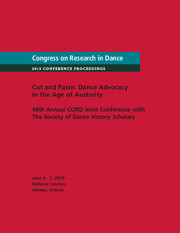No CrossRef data available.
Article contents
Between Resistance and Restraint: The Corporeal Practice of Ballet in a University Classroom
Published online by Cambridge University Press: 04 January 2013
Abstract
This essay uses ballet as an example of how dance can be rooted in a discourse of difference that women must learn to overcome. Contributing to the growing research on ballet produced by Jennifer Fisher (and others), this article explores the practice of ballet from the perspective of three female students enrolled in a university-level intermediate ballet class. Based on ethnographic material that was brought together by observing the body practices in the ballet classroom and interviewing the students about their experience with ballet, I explore the intersection between ballet and the lives of the female participants. In describing how the students understand their bodies in relation to the rigid structures of ballet, I show that it is precisely those structures that imbue the students with a sense of agency and self-expression. I also reveal that by conforming to the structures of ballet, the students are achieving higher levels of thinking that allow them to negotiate their everyday lived experiences.
- Type
- Research Article
- Information
- Congress on Research in Dance Conference Proceedings , Volume 40 , supplement S1: Dance Studies and Global Feminisms , 2008 , pp. 263 - 272
- Copyright
- Copyright © The Author(s) 2008


